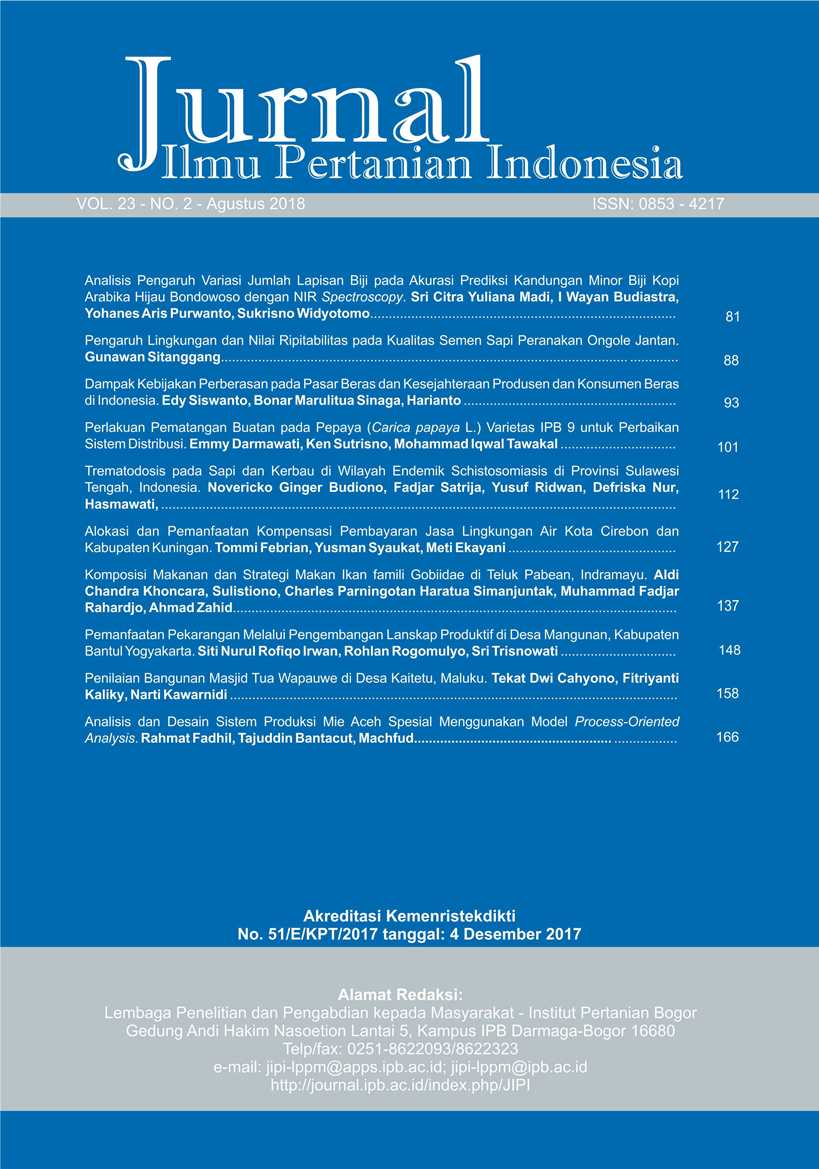Perlakuan Pematangan Buatan pada Pepaya (Carica papaya L.) Varietas IPB 9 untuk Perbaikan Sistem Distribusi
Abstract
Papayas as a climacteric fruit are commontly harvested and distributed in an unripe state with various of maturities. Ripening is required before papaya ready for consumption. The objectives of this research were to analyze the response of artificial ripening treatment for papaya in order to perform the best marketing schedule. This study was started by harvesting, sorting, cleaning, hot water treatment, and transportation simulation similar to 90.44 km, storage in refrigerator at 15 °C, artificial ripening treatment and storage at room temperature. Physical quality parameters measured consisted of weight loss, color, firmness, and total soluble solid. Artifial ripening using ethephon will accelerate the maturation of papaya. Papaya with maturity level of 60% (yellow tinge) that stored at 15 °C for 7 days was found still not ready to be consumed as a table fruit, and it was still necessary to artificially ripening process. Artificial ripening using ethephon of 250 and 750 ppm did not significantly affect the fruit color, hardness, and total soluble solids. This papaya could be consumed after 2 days of ripening and reached the optimum conditions for consumption after 4 days, with a possibility of shelf life for 6 days at room temperature. The best artificial ripening treatment for papaya that had been stored 14 days at 15 °C was by using 250 ppm of ethephon. The use of 250 ppm ethephon would make the best visually and smoothly yellow color of papaya’s peel surface.
Downloads
References
Abu Goukh ABA, Shattir AET, Mahdi EFM. 2010. Physico-chemical changes during growth and development of pepaya fruit. ii : chemical changes. Journal Agriculture and Biology Journal of North America. 1(5): 871-877. https://doi.org/10.5251/abjna.2010.1.5.871.877
Adane ZW, Ibrahim AM, Yohannes DB, Welde-Meskel TA. 2015. Effect of traditional kerosene smoking and ethrel on ripening, shelf life and quality of cavendish banana (Musa sp.). African Journal of Agricultural Research. 10(50): 4570-4583. https://doi.org/10.5897/AJAR2015.10299
Billy L, Mehinagic E, Royer G, Renard CMGC, Arvisenet G, Prost C, Jourjon F. 2008. Relationship between texture and pectin composition of two apple cultivars during storage. Journal Postharvest Biology and Technology. 47: 315-324. https://doi.org/10.1016/j.postharvbio.2007.07.011
Duan X, Cheng G, Yang E, Yi C, Ruenroengklin N, Lu W. 2008. Modification of pectin polysaccharides during ripening of post-harvest banana fruit. Fd. Chem. 111: 144-149. https://doi.org/10.1016/j.foodchem.2008.03.049
Monolopoulou H, G Xanthopoulos, N Douros dan Gr Lambrinos. 2010. Modified Atmosphere Packaging Storage of Green Bell Peppers: Quality Criteria. Biosystems Enginering. 106: 535-543.
Pantastico EB. 1989. Fisiologi Pascapanen. Penanganan dan Pemanfaatan Buah-Buahan Tropika dan Subtropika. Kamaryani, penerjemah. Yogyakarta (ID):Gadjah Mada University Press. Terjemahan dari:Postharvest Physiology, Handling, and Utilization of Tropical and Sub-tropical Fruits and Vegetables.
Prasanna V, Prabha TN, Tharanathan RN, 2007. Fruit ripening phenomena-an overview. Critical Reviews in Food and Nutrition. 47(1): 1-19. https://doi.org/10.1080/10408390600976841
Sacharow S, Griffin RC. 1980. Principles of Food Packaging. Westport, Connecticut (US). The AVI Publ Company Inc.
Seymour GB, Taylor JE, Tucker GA. 1993. Biochemistry of Fruit Ripening. London (EN): Chapman and Hall. https://doi.org/10.1007/978-94-011-1584-1
Shattir AET, Abu Goukh AA. 2010. Physico-chemical changes during growth and development of papaya fruit. Ι: Physical changes. Agriculture and Biology Journal of North America. 1(5): 866-870. https://doi.org/10.5251/abjna.2010.1.5.866.870
Simson SP, Straus WC. 2010 Post Harvest technology of Horticultural Crops. India (IN): Oxford Book Company.
Singal S, Kumud M, Thakral S. 2012. Application of apple as a ripening agent for banana. Indian Journal of natural Products and resources. 3(1): 61-64.
Singh P, Kumar S, Maji S. 2014 Studies on the ethrel and different wrapping materials on post-harvest changes of papaya fruits (Carica papaya L.). international Journal of Food and Nutritional Science. 3(6): 97-107.
Wills R, Mcglasson B, Graham D, Joyce D. 1998. Post Harvest : An Introduction to the Physiology and Handling on Fruits and Vegetable. Australia (AU): NSW Pr Limited.
Xueping L, Xiaoyang Z, Zhao N, Danwen F, Li J, Weixin C. 2013. Effects of hot water treatment on anthracnose disease in papaya fruit and its possible mechanism. Journal Postharvest Biology and Technology. 86: 437-446. https://doi.org/10.1016/j.postharvbio.2013.07.037
Znidarcic D, Ban II D, Milan O, M, Karic L, Pozra T, 2010. Influence of postharvest temperatures on physicochemical quality of tomatoes (Lycopersicon esculentum Mill.). Journal of Food, Agriculture and Environment. 8: 21-25.
This journal is published under the terms of the Creative Commons Attribution-NonCommercial 4.0 International License. Authors who publish with this journal agree to the following terms: Authors retain copyright and grant the journal right of first publication with the work simultaneously licensed under a Creative Commons Attribution-NonCommercial 4.0 International License. Attribution — You must give appropriate credit, provide a link to the license, and indicate if changes were made. You may do so in any reasonable manner, but not in any way that suggests the licensor endorses you or your use. NonCommercial — You may not use the material for commercial purposes.























